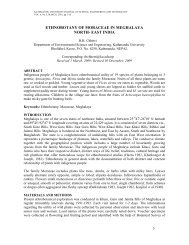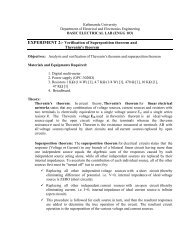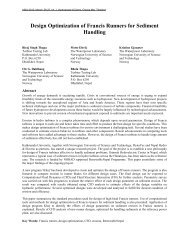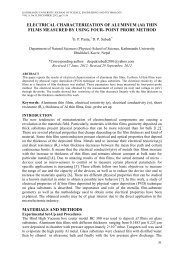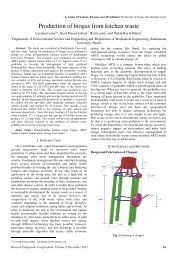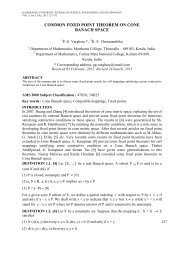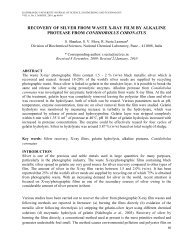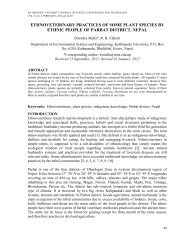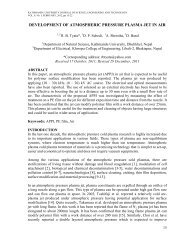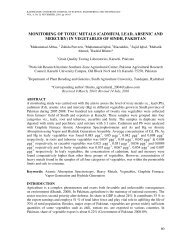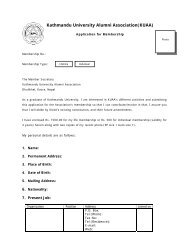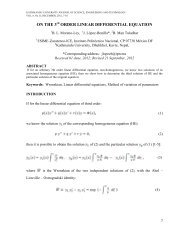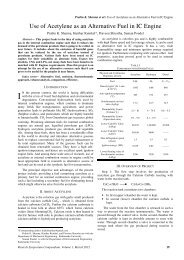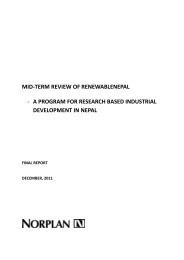ENVS 434: Watershed Management
ENVS 434: Watershed Management
ENVS 434: Watershed Management
You also want an ePaper? Increase the reach of your titles
YUMPU automatically turns print PDFs into web optimized ePapers that Google loves.
<strong>ENVS</strong> 435: <strong>Watershed</strong> <strong>Management</strong><br />
3 Credits<br />
INSTR.: Dr. R.M. Bajracharya
Unit 1: Introduction - <strong>Watershed</strong> Concepts<br />
• Definitions of watershed<br />
• “The elevated line separating the head<br />
streams which are tributaries of different<br />
river systems of basins”. (Moore’s Dictionary of<br />
Geography, 4 th Ed.)<br />
• “An area drained by a river” –<br />
synonymous with the terms catchment or<br />
basin. (Cassell et al., 1982)<br />
• Segments which make up landscape<br />
patterns such as a mature river valley,<br />
which are eroded by a river system. (Backett<br />
& Webster, 1962; Gregory & Brown, 1966)
Definition of <strong>Watershed</strong> continued<br />
• “Topographic, hydraulic and hydrologic units within<br />
a basin” (Horton, 1945)<br />
• Strahler (1964) and Lee (1964) define watershed as:<br />
• A limited, convenient and usually clearly defined and<br />
unambiguous topographic unit, available in a nested<br />
hierarchy of sizes on the basis of stream ordering, and,<br />
• An open physical system in terms of inputs of precipitation<br />
and solar radiation, and outputs of discharge, evaporation<br />
and reradiation.<br />
• As a development unit, Gibbs (1986) defined it as:<br />
“a readily defined, functional unit established by a<br />
relationship between physical and cultural<br />
influences”.
<strong>Watershed</strong> as an ecosystem<br />
• Paembonan (1985) defines watershed as an<br />
“ecosystem” in itself, consisting of production,<br />
protection, and multipurpose subsystems.<br />
Protection<br />
sub-system<br />
Production<br />
Sub-system<br />
Multipurpose or<br />
rural sub-system
Meaning of watershed and catchment<br />
• According to British<br />
usage:<br />
• Catchment is the area<br />
from which runoff occurs,<br />
and,<br />
• watershed is the boundary<br />
of a catchment.<br />
• According to American<br />
usage:<br />
• <strong>Watershed</strong> is the total area<br />
catching the runoff, and,<br />
• Divide (or drainage divide)<br />
is the boundary between<br />
two watersheds.<br />
• Catchment is also called<br />
a Drainage Basin<br />
<strong>Watershed</strong> or<br />
catchment area<br />
divide<br />
streams<br />
river<br />
Sub-watershed or<br />
sub-catchment
What then is a watershed<br />
• It is the area bounded by a drainage divide and<br />
draining all the water incident upon it through a<br />
common outlet (stream or river), or to a common<br />
point/place (lake, pond).<br />
• Or simply, all the land within the confines of a<br />
drainage divide.<br />
• <strong>Watershed</strong>, catchment, drainage area, river basin,<br />
drainage basin, are all terms used interchangeably.<br />
• BUT generally:<br />
• <strong>Watershed</strong>, catchment and drainage area are used for<br />
small streams and rivers, while,<br />
• Drainage basin and river basin are used for large river<br />
systems with numerous sub-watersheds or sub-catchments<br />
nested within it.
Meaning of a “divide”<br />
• A “divide” or “drainage divide” is the line drawn<br />
through the highest elevated points within a<br />
watershed.<br />
• It forms the limits of a single watershed and the<br />
boundary between two or more watersheds.<br />
• A water divide is categorised into:<br />
• Surface water divide – highest elevation line between<br />
basins (watersheds) that defines the perimeter and sheds<br />
water into adjacent basins, and,<br />
• Subsurface water divide – which refers to faults, folds, tilted<br />
geologic strata (rock layers), etc., that cause sub-surface<br />
flow to move in one direction or the other.<br />
Surface<br />
water divide<br />
Subsurface<br />
water divide
<strong>Watershed</strong> <strong>Management</strong> policies and<br />
principles in Nepal<br />
• The primary responsibility and authority for the<br />
management and development of watersheds in<br />
Nepal lies with the Dep. Of Soil Conservation and<br />
<strong>Watershed</strong> <strong>Management</strong> (DSCWM) within HMG<br />
Ministry of Forest and Soil Conservation.<br />
• The policy of the Nepalese government has been to<br />
give overall responsibility to manage and conserve<br />
watersheds and their resources (water, land, forests,<br />
biodiversity, etc.) to the DSCWM, although watersheds<br />
are complex, dynamic entities falling into several<br />
sectors of development:<br />
• Agriculture<br />
• Forestry<br />
• Water resources<br />
• Biodiversity (flora & fauna), etc.
DSCWM’s watershed management strategy<br />
• The basic strategy of DSCWM in watershed<br />
management and conservation is as follows:<br />
• Break down major river basins across Nepal in to subwatersheds<br />
of a few to 25 sq. km.<br />
• Identify and select priority sub-watersheds for development<br />
planning and conservation activities according to level of<br />
need and status of degradation.<br />
• Collect sufficient biophysical and socioeconomic<br />
information for integrated watershed management<br />
planning.<br />
• Prepare a sub-watershed management plan for each<br />
priority sub-watershed in order to minimize natural and<br />
human-induced hazards and to conserve valuable<br />
resources (soil, water, biodiversity, socio-cultural aspects).<br />
• Implement various integrated watershed mgmt. activities in<br />
the selected priority sub-watershed.
Policy Framework for <strong>Watershed</strong> <strong>Management</strong> in<br />
Nepal<br />
• HMG Nepal has, as a major policy focus, the<br />
protection and conservation of natural resources,<br />
as well as, its proper and beneficial utilization.<br />
• Water resource use, protection and management<br />
• Proper and scientific use and management of land<br />
• Maintenance and preservation of ecological balance<br />
• Conservation & preservation of biological diversity<br />
• National Council for Conserv. of Natural Resources<br />
• These have been highlighted in the National<br />
Conservation Strategy (NCS) and in numerous 5-<br />
year plans (6 th through 10 th ).<br />
• The main legal reference to watershed<br />
management is the “Soil Conservation and<br />
<strong>Watershed</strong> <strong>Management</strong> act” of 1982.
Policy framework continued . . .<br />
• The SCWM Act (1982) is supported by other policies and Acts:<br />
• National parks & wildlife conser. Act (NPCWA) – 1973<br />
• Soil and water conservation act (SWCA) – 1982<br />
• Water resources act – 1992<br />
• Electricity Act – 1992<br />
• Prospective Land Use Plan (1986)<br />
• The APP (1995)<br />
• The Forest Act (1993)<br />
• Nepal Environmental Policy and Action Plan (1993)<br />
• In recent years other related policy and legal measures are<br />
being formulated:<br />
• National EIA guidelines with regard to industry, projects,<br />
various development sectors; protected areas & forests<br />
• Environmental Protection Act (1997)<br />
• Action plan for conservation of biological diversity (1995-<br />
2000)
Concept of <strong>Watershed</strong> <strong>Management</strong> and its<br />
consideration in project planning<br />
• <strong>Watershed</strong> management (WSM) is the process of<br />
guiding and organizing the use of land & other<br />
resource in a watershed to provide desired goods<br />
and services without adversely affecting the<br />
environment or ecological balance.<br />
• It involves multiple resource types & requires<br />
understanding of the relationships among land use,<br />
soil, water, flora, fauna and human communities.<br />
• Also important are linkages between upland and<br />
downstream areas & their interdependence.<br />
• NOTE: Economic, social & political forces that shape<br />
development work within socio-political boundaries,<br />
while the forces of nature affecting land & water<br />
resources respect only natural (watershed)<br />
boundaries.
<strong>Watershed</strong> management projects<br />
• These involve actions aimed at “production [of<br />
goods & services] with protection [of the natural<br />
resource base]”<br />
• The overall objective of WSM is to achieve the<br />
most appropriate use of land, water and other<br />
resources so that economic and social<br />
development within a watershed can be attained<br />
on a sustainable basis.<br />
• Any WSM project must have the following basic<br />
components:<br />
1. A definable set of inputs (land, materials, people)<br />
2. A definable set of outputs (goods or services)<br />
3. A definable set of activities or processes (technical<br />
and/or institutional) to transform inputs into outputs.
Project planning in watershed management<br />
• Major objectives in WSM project planning:<br />
• Restoration of degraded lands (land use categories)<br />
• Protection or prevention of watershed degradation<br />
• Mitigate, to an acceptable level, effects of land use<br />
practices (designed to produce needed goods & services)<br />
• Broad categories of linkages among watershed<br />
practices and benefits in upstream & downstream<br />
areas (regarded as environmental changes):<br />
• Stabilization of soil and steep slopes<br />
• Improvement stream flow pattern and/or water yield<br />
• Maintenance and improvement of water quality<br />
• Maintenance & enhancement of biodiversity (natural &<br />
agricultural)
Project planning in WSM, continued<br />
• Planners should therefore consider the following<br />
realities in WSM projects:<br />
• Dynamic and complex interaction of water with land,<br />
vegetation and other resources as influenced by climate &<br />
topography<br />
• Interaction and impacts between natural resources and<br />
people<br />
• Implications of these interactions and socio-political<br />
boundaries<br />
• Concepts of sustainable and equitable resource use within<br />
and across ecological and national (political) boundaries<br />
• Existence of externalities (unanticipated or undesired sideeffects)<br />
• Need for environmentally/ecologically sound<br />
management
Summary<br />
• A <strong>Watershed</strong> is the area within a drainage divide for<br />
which all water falling upon is drained through a<br />
common stream or to a common point.<br />
• <strong>Watershed</strong>s are natural bio-geophysical units that<br />
are important in terms of ecologically sound mgmt.<br />
• Human society and rural communities are also<br />
integral components of many watersheds.<br />
• The development of a watershed management<br />
plan needs to integrate biophysical, socio-cultural<br />
and politico-economic factors to ensure that the<br />
plan/project will be technically sound, socially<br />
acceptable, economically feasible, and<br />
environmentally friendly.



